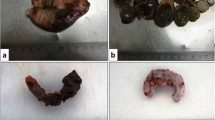Abstract
Purpose
Appendicitis is by far the commonest major emergency general surgical operation. Histopathological examination of the appendix is routinely performed.
Methods
This study is a retrospective analysis of 24,697 appendectomies performed from January 2003 to December 2011. Pathological reports were analyzed for the following parameters: age, gender, and pathological diagnosis.
Results
Appendectomy specimens represent 17 % of all pathological reports. Acute appendicitis was present in 19,637 (79.5 %) patients. The perforation rate was 6.3 % and was significantly higher in adult patients. The negative appendectomy rate was 15 % and was significantly higher in female and adult patients. The incidence of negative appendectomies had clearly decreased over the 9-year period distribution. Incidental unexpected pathological diagnoses were noted in 226 (0.9 %) appendectomy specimens. Neoplastic lesions were present in 171 cases (0.7 %); they include carcinoid, adenocarcinoma, and mucinous neoplasms.
Conclusions
Routine pathological examination of appendectomy specimens is expensive. With advances in technology and imaging modalities, the diagnosis of acute appendicitis has improved, with a subsequent significant reduction in negative appendectomy. There are still a number of unusual diagnoses found in appendicectomy specimens supporting the continued use of routine histology.

Similar content being viewed by others

References
Lohsiriwat V, Vongjirad A, Lohsiriwat D (2009) Value of routine histopathologic examination of three common surgical specimens: appendix, gallbladder, and hemorrhoid. World J Surg 33:2189–2193
Matthyssens LE, Ziol M, Barrat C et al (2006) Routine surgical pathology in general surgery. Br J Surg 93:362–368
Khan RA, Ghani I, Chana RS (2011) Routine histopathological examination of appendectomy specimens in children: is there any rationale? Pediatr Surg Int 27:1313–1315
Swank HA, Eshuis EJ, Ubbink DT et al (2011) Is routine histopathological examination of appendectomy specimens useful? A systematic review of the literature. Colorectal Dis 13:1214–1221
Akbulut S, Tas M, Sogutcu N et al (2011) Unusual histopathological findings in appendectomy specimens: a retrospective analysis and literature review. World J Gastroenterol 17:1961–1970
Zachert HR, Meyer HJ (1998) Acute appendicitis in advanced age. Fortschr Med 116:36–39
Williams NM, Jackson D, Everson NW et al (1998) Is the incidence of acute appendicitis really falling? Ann R Coll Surg Engl 80:122–124
Rao PM, Rhea JT, Rattner DW et al (1999) Introduction of appendiceal CT: impact on negative appendectomy and appendiceal perforation rates. Ann Surg 229:344–349
Rhea JT, Halpern EF, Ptak T et al (2005) The status of appendiceal CT in an urban medical center 5 years after its introduction: experience with 753 patients. AJR Am J Roentgenol 184:1802–1808
Wagner PL, Eachempati SR, Soe K et al (2008) Defining the current negative appendectomy rate: for whom is preoperative computed tomography making an impact? Surgery 144:276–282
Hussain A, Mahmood H, Singhal T et al (2009) What is positive appendicitis? A new answer to an old question. Clinical, macroscopical and microscopical findings in 200 consecutive appendectomies. Singapore Med J 50:1145–1149
Singhal V, Jadhav V (2007) Acute appendicitis: are we over diagnosing it? Ann R Coll Surg Engl 89:766–769
Nemeth L, Reen DJ, O'Briain DS et al (2001) Evidence of an inflammatory pathologic condition in "normal" appendices following emergency appendectomy. Arch Pathol Lab Med 125:759–764
Khairy G (2009) Acute appendicitis: is removal of a normal appendix still existing and can we reduce its rate? Saudi J Gastroenterol 15:167–170
Rothrock SG, Green SM, Dobson M et al (1995) Misdiagnosis of appendicitis in nonpregnant women of childbearing age. J Emerg Med 13:1–8
Rabah R (2007) Pathology of the appendix in children: an institutional experience and review of the literature. Pediatr Radiol 37:15–20
Marudanayagam R, Williams GT, Rees BI (2006) Review of the pathological results of 2660 appendicectomy specimens. J Gastroenterol 41:745–749
Ricci MA, Trevisani MF, Beck WC (1991) Acute appendicitis. A 5-year review. Am Surg 57:301–305
Colson M, Skinner KA, Dunnington G (1997) High negative appendectomy rates are no longer acceptable. Am J Surg 174:723–726
Yilmaz M, Akbulut S, Kutluturk K (2013) Unusual histopathological findings in appendectomy specimens from patients with suspected acute appendicitis. World J Gastroenterol 19:4015–4022
Ariyarathenam AV, Nachimuthu S, Tang TY et al (2010) Enterobius vermicularis infestation of the appendix and management at the time of laparoscopic appendectomy: case series and literature review. Int J Surg 8:466–469
Sodergren MH, Jethwa P, Wilkinson S et al (2009) Presenting features of Enterobius vermicularis in the vermiform appendix. Scand J Gastroenterol 44:457–461
Jones AE, Phillips AW, Jarvis JR et al (2007) The value of routine histopathological examination of appendicectomy specimens. BMC Surg 10:7–17
Chandrasegaram MD, Rothwell LA, An EI et al (2012) Pathologies of the appendix: a 10-year review of 4670 appendicectomy specimens. ANZ J Surg 82:844–847
Attwood SE, Mealy K, Cafferkey MT et al (1987) Yersinia infection and acute abdominal pain. Lancet 7:529–533
Gupta SC, Gupta AK, Keswani NK et al (1989) Pathology of tropical appendicitis. J Clin Pathol 42:1169–1172
Ojo OS, Udeh SC, Odesanmi WO (1991) Review of the histopathological findings in appendices removed for acute appendicitis in Nigerians. J R Coll Surg Edinb 36:245–248
Martellucci J, Fontani A, Tanzini G (2009) Is routine pathological examination necessary in appendectomy for acute appendicitis? Int J Colorectal Dis 24:1243
Author information
Authors and Affiliations
Corresponding author
Rights and permissions
About this article
Cite this article
Charfi, S., Sellami, A., Affes, A. et al. Histopathological findings in appendectomy specimens: a study of 24,697 cases. Int J Colorectal Dis 29, 1009–1012 (2014). https://doi.org/10.1007/s00384-014-1934-7
Accepted:
Published:
Issue Date:
DOI: https://doi.org/10.1007/s00384-014-1934-7



